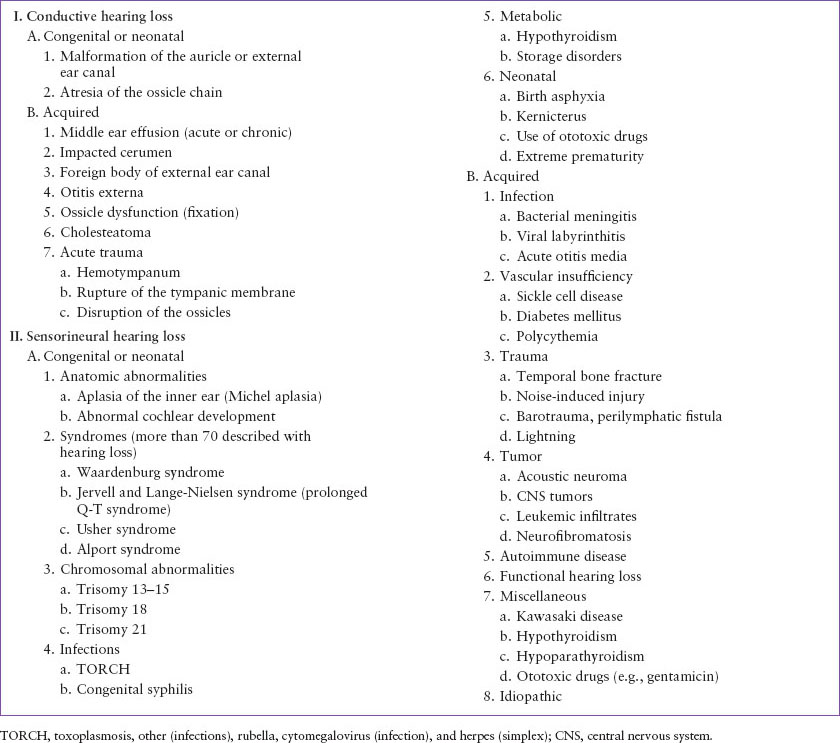HEARING LOSS
ROBERT J. VINCI, MD
Hearing loss during early childhood may compromise the ability to attain normal language. Therefore, early recognition of hearing loss, with appropriate evaluation and treatment, is crucial to avoid cognitive impairment, which may negatively impact school performance, socialization, and emotional development.
Acute hearing loss is of two main types: conductive and sensorineural. Conductive hearing loss is caused by abnormal transmission of sound waves to the inner ear, whereas sensorineural hearing loss is caused by defective processing of sound waves (Table 30.1). Etiologies may be congenital or acquired. Hearing loss can occur as an isolated symptom or in association with auditory or central nervous system (CNS) dysfunction. The emergency physician must identify the etiology of hearing loss, especially those disorders that are associated with serious systemic disease.
PATHOPHYSIOLOGY
Normal hearing is dependent on an intricate series of properly aligned anatomic and physiologic connections. The auricle or outer ear is designed to receive sensory transmission, or “sound waves,” from the child’s environment. When patent, the external ear canal transmits sound waves to the tympanic membrane and vibrations of the membrane produce movement of the middle ear ossicles, which result in the transmission of fluid waves to the inner ear fluid within the cochlea. Here the specialized receptors, hair cells in the spiral organ of Corti, convert this mechanical energy to nerve impulses that are transmitted by the cochlear (acoustic) nerve, the auditory portion of the eighth cranial nerve, to the brain. These nerve impulses are integrated by the brain and transformed into what is perceived as sound. It is important to note that anatomically the acoustic apparatus is closely related to the vestibular system, which is concerned with the proprioceptive senses of posture and equilibrium. Therefore, abnormalities in the inner ear may cause both auditory and vestibular symptoms.
DIFFERENTIAL DIAGNOSIS
Conductive Hearing Loss
In children, conductive hearing loss occurs when there is a decrease in the transmission of sound waves from the external environment to the cochlea or inner ear. Commonly, middle ear effusion (either acute or chronic), impacted cerumen, foreign body of the external ear canal, and infections of the external ear canal (otitis externa) may produce conductive hearing loss. Less commonly, fixation or disruption of the middle ear ossicles may cause conductive hearing loss (Table 30.1). In children with chronic recurrent/otitis media (OM), a cholesteatoma—an epidermal inclusion cyst of the middle ear—may develop and cause a slowly progressive conductive hearing loss. Acute head injury, especially in association with a basilar skull fracture, may produce a conductive hearing loss caused by hemotympanum, rupture of the tympanic membrane, or disruption of the inner ear ossicle. Perforation of the tympanic membrane can occur from a self-inflicted injury from a cleaning device such as a cotton swab. Rarely, the conductive hearing loss may be secondary to congenital malformations of the external or middle ear.
Congenital Sensorineural Hearing Loss
Approximately 1.4 in 1,000 infants are born with congenital hearing loss. Diagnostic possibilities include genetic disorders, chromosomal abnormalities, metabolic and storage diseases, and abnormal development of the auditory apparatus (Table 30.1). Sensorineural hearing loss has been described in more than 70 syndromes, including Waardenburg syndrome (facial dysmorphism, white forelock), Jervell and Lange-Nielsen syndrome (prolonged Q-T syndrome), Usher syndrome (retinitis pigmentosa and sensorineural hearing loss) as well as the chromosomal disorders caused by trisomies (especially trisomies 13 to 15, 18, and 21). Many of these patients are diagnosed because of anatomic features associated with each of these disorders, although the hearing loss that occurs may be present at birth or may develop over time. Overall, one-third of patients with congenital hearing loss have associated clinical symptoms of a known syndrome. Recent advances in genetic testing have begun to elucidate gene abnormalities in patients with nonsyndromic hearing loss.
Acquired Sensorineural Hearing Loss
Although acquired sensorineural hearing loss occurs less commonly than congenital sensorineural hearing loss, the absence of associated symptoms may make it a more difficult diagnosis. An array of clinical problems can produce sensorineural hearing loss during childhood.
Acute Infection
Bacterial meningitis is the most common cause of acquired sensorineural hearing loss. Reported in 10% to 20% of patients with meningitis, the hearing loss is usually profound and often bilateral. The hearing loss associated with meningitis is organism specific and most commonly associated with Streptococcus pneumoniae but was also associated with infections caused by Haemophilus influenzae and Neisseria meningitidis. Vaccine programs that have led to a decrease in the incidence of these bacterial pathogens have been instrumental in decreasing the occurrence of this complication. For patients with acute bacterial meningitis, adjunctive therapy with dexamethasone may decrease the incidence of neurologic sequelae, including hearing loss.
TABLE 30.1
DIFFERENTIAL DIAGNOSIS OF HEARING LOSS

Congenital infection caused by cytomegalovirus (CMV) is the most common intrauterine infection that produces sensorineural hearing loss. Congenital infection from rubella, syphilis, toxoplasmosis and perinatally acquired herpes simplex infections are also associated with acquired sensorineural hearing loss. The hearing loss associated with these infections may occur in infants without other manifestations of congenital infection, and may not develop until early childhood. Thus, many experts advocate for universal newborn hearing screening and regular monitoring of children with known congenital infections or high-risk infants such as neonatal intensive care unit patients.
Stay updated, free articles. Join our Telegram channel

Full access? Get Clinical Tree







